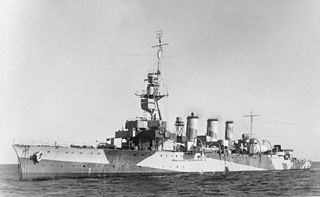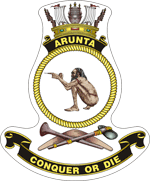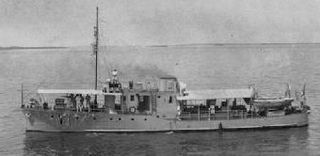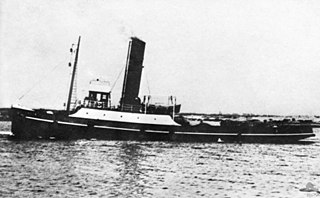
HMAS Barcoo (K375/F375/A245) was a River-class frigate of the Royal Australian Navy (RAN). One of twelve frigates constructed in Australia during World War II, Barcoo, was laid down by Cockatoo Docks & Engineering Company, Sydney in 1942, and commissioned in early 1944.

HMAS Adelaide was a Town-class light cruiser of the Royal Australian Navy (RAN), named after Adelaide, the capital city of South Australia. Laid down in 1915, wartime shortages and design modifications meant the ship was not completed until 1922, earning her the nickname "HMAS Longdelayed".

HMAS Quiberon (G81/D20/D281/F03) was a Q-class destroyer of the Royal Australian Navy (RAN). Although built for the Royal Navy and remaining British property until 1950, Quiberon was one of two Q-class destroyers commissioned into the RAN during World War II. She was passed into full RAN ownership in 1950, and converted into an anti-submarine frigate.
HMAS Flinders, named for Matthew Flinders (1774–1814), was a hydrographic survey ship of the Royal Australian Navy (RAN). Built by HMA Naval Dockyard at Williamstown, Victoria, Flinders was commissioned into the RAN in 1973, and was used to conduct hydrographic surveys in the waters to Australia's north, including parts of New Guinea. In 1974, the ship was tasked with assisting clean up efforts in the wake of Cyclone Tracy, which devastated large parts of Darwin. The ship was decommissioned in 1998 and sold to civilian operators, who have since converted her into a private yacht in the Cayman Islands.

HMAS Melbourne (R21) was a Majestic-class light aircraft carrier operated by the Royal Australian Navy (RAN) from 1955 until 1982, and was the third and final conventional aircraft carrier to serve in the RAN. Melbourne was the only Commonwealth naval vessel to sink two friendly warships in peacetime collisions.

HMAS Arunta (I30/D5/D130) was a Tribal-class destroyer of the Royal Australian Navy (RAN). Named for the Arrernte Aboriginal peoples, the destroyer was laid down in 1939 and commissioned into the RAN in 1942.

The Cockatoo Island Dockyard was a major dockyard in Sydney, Australia, based on Cockatoo Island. The dockyard was established in 1857 to maintain Royal Navy warships. It later built and repaired military and battle ships, and played a key role in sustaining the Royal Australian Navy. The dockyard was closed in 1991, and its remnants are heritage listed as the Cockatoo Island Industrial Conservation Area.

HMAS Bungaree was an auxiliary minelayer of Royal Australian Navy (RAN), serving during World War II. The ship was built as a cargo vessel for the Adelaide Steamship Company by Caledon Shipbuilding & Engineering Company at Dundee, and launched in 1937. The ship operated in Australian waters and was requisitioned by the RAN in October 1940. Decommissioned on 7 August 1946 and returned to her owners on 5 November 1947, she was sold in 1957 and renamed Dampier. She was then sold in 1960 and renamed Eastern Mariner and while operating in South Vietnamese waters she struck a mine on the Saigon River and was sunk on 26 May 1966. She was salvaged by a Japanese company and subsequently scrapped in 1968.

HMAS Diamantina (K377/F377/A266/GOR266), named after the Diamantina River in Queensland, is a River-class frigate that served the Royal Australian Navy (RAN). Constructed in the mid-1940s, Diamantina was active from 1945 until 1946, was placed in reserve, then was recommissioned as a survey ship from 1959 until 1980.

Forceful is a sea-going tugboat built for the Queensland Tug Company by Alexander Stephen and Sons Ltd in Govan, Scotland in 1925. She worked at her homeport of Brisbane, Australia between 1926 and 1970 berthing ships and assisting nearby casualties. During World War II she was commissioned into the Royal Australian Navy in early 1942 as HMAS Forceful (W126), based at Fremantle and Darwin, until returning to commercial service in October 1943. She is preserved as a museum ship at Brisbane.

HMAS Vigilant was an auxiliary patrol boat serving with the Royal Australian Navy during the Second World War. Notably it was the 120th ship built by the Cockatoo Island Dockyard and the first aluminium ship built in Australia.

Adele was a steel screw steamer that was built in 1906 as a yacht. She was twice commissioned into the Royal Australian Navy (RAN), firstly as HMAS Franklin and later as HMAS Adele. She was wrecked at Port Kembla, New South Wales on 7 May 1943.

HMAS Durraween (F93) was an auxiliary minesweeper operated by the Royal Australian Navy (RAN) during World War II. The ship was built as a trawler by Collingwood Shipbuilding Company at Collingwood, Ontario, Canada, and launched in 1918 as Seville. The ship served briefly in the Royal Canadian Navy during the last months of World War I, before being laid up and sold to a British company. In 1928, she was sold to Sydney-based fishing company and operated in Australian waters until she was requisitioned by the RAN in mid-1940 for use as an auxiliary minesweeper during World War II. Durraween operated in the Bass Strait as part of Minesweeping Group 54, and was responsible for clearing mines laid by German merchant raiders, and then later operated around the Torres Strait. She was returned to civilian service after paying off in late 1945, and was broken up in 1952.

HMAS Olive Cam was an auxiliary minesweeper operated by the Royal Australian Navy (RAN) during World War II. She was launched in 1920 by Cook, Welton & Gemmell at Beverley as Nodzu. The ship operated in Australian waters from 1929, and was requisitioned by the RAN on 3 September 1939. She was returned to her owners in 1946 before being wrecked near Green Cape Lighthouse, Eden, New South Wales on 2 November 1954 with the loss of three lives.

HMAS Wato (W127) was a tug boat operated by the Royal Australian Navy (RAN) during World War II. During World War I she was operated by the Royal Navy in the Mediterranean Sea. She later operated as a tug boat for the Adelaide Steam Tug Company before being requisitioned by the RAN. She was scrapped in 1955.
HMAS Medea was an auxiliary minesweeper of the Royal Australian Navy (RAN) between 1942 until 1946. Built in 1912 for the Ocean Steam Ship Co. she was sold to the Straits Steam Ship Co. in 1925. She was requisitioned by the Royal Navy in 1939 and converted into an auxiliary minesweeper and named HMS Circe. She was transferred to the Royal Australian Navy in 1942 and renamed HMAS Medea until she was returned to her owners in 1946. She was sold and was scuttled off Sydney on 20 January 1948.

HMAS Mercedes was an auxiliary minesweeper of the Royal Australian Navy (RAN) between 1942 until 1946. Built in 1913 for the Ocean Steam Ship Co. she was sold to the Straits Steam Ship Co. in 1925. She was requisitioned by the Royal Navy in 1939 and converted into an auxiliary minesweeper and named HMS Medusa. She was transferred to the Royal Australian Navy in 1942 and renamed HMAS Mercedes until she was returned to her owners in 1946. She was sold and was scuttled off Sydney on 23 January 1948.

HMAS Yunnan (FL-151) was a 2,812-ton former steamer that was commissioned into the Royal Australian Navy (RAN) during the Second World War. It was one of a group of vessels known as the "China Fleet" acquired by the RAN in similar circumstances. During the war, the ship operated as an ammunition supply vessel in the Pacific. At the conclusion of hostilities, she was transferred to the British, and was eventually sold to civilian owners. She was broken up in 1971.
HMAS St Giles (FY86) was a tugboat which was operated by the Royal Navy (RN), Royal Australian Navy (RAN) and the Australian shipping firms J. & A. Brown and the Waratah Tug and Salvage Company. She was built by Ferguson Shipbuilders, Glasgow for the RN in 1919, was sold to J. & A. Brown in 1925, transferred to the Waratah Tug and Salvage Co Pty Ltd in 1931 and was commissioned into the RAN between 1940 and 1942 and 1945 and 1946 before being scrapped in 1956.
The Cockatoo Docks & Engineering Company was a ship building and maintenance company which operated the Cockatoo Island Dockyard on Cockatoo Island in Sydney, Australia between 1933 and 1992.















